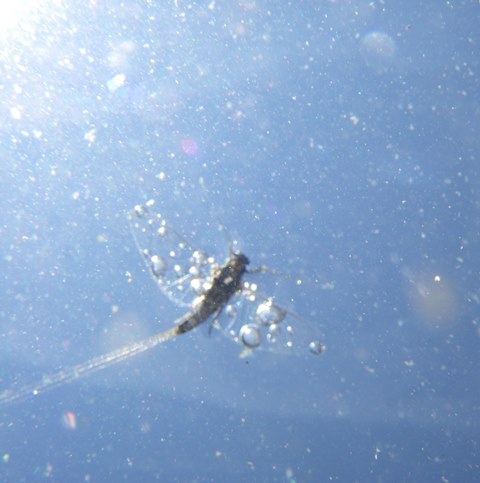It’s early Sunday morning. I’m on
the South Platte River tailwater below Spinney Mountain Reservoir, AKA the Dream
Stream, in South Park, Colorado. The trico mating swarms overhead are as heavy
as I’ve seen in a long time. Several small trout are already rising to either
the last of the duns or the first of the spent spinners.
The one problem is that I left my
trico fly box in the truck. I didn’t leave it there by design as part of the minimalist
fly fishing kick I’ve been on lately. I just spaced it out. Anyway, the truck
is a 15 minute walk away. I know I should hustle back up to it and get the fly
box, but I decide against it over the objections of my logical, scientific
mind. I’ll be heroic and fish the fly imitations I have with me. Almost on cue
a size 24 trico spinner descends from the mating swarm and lands on my hand.
The trouble is I don’t know if that’s a good or bad omen.
I have this idea that I can modify
something in my fly box to make it work. It’s not on the same order as that
story you hear about the great violinist who breaks a string during a performance
and finishes his solo using the three strings he has left, but somehow this
challenge has inspired me.
The closest imitation to a trico I
can find in my fly box looks something like an RS-2 nymph. It’s small, dark and
tied sparse. It could pass for a trico dun that lies stillborn or crippled on
the water’s surface or a spent trico spinner that has crashed into the water
and ripped its wings off. I rumple up the little stump of a wing on the fly to
enhance the deception. A few minutes later I’m busy casting it to dimpling
trout and manage to land a 3-inch rainbow trout and then another and another. They
must be stocked “sub-catchables”. I’ve caught
little bitty trout on spent trico spinner imitations before in September, but
at least they were 3-inch long young-of-the-year wild brown trout. It looks like the curse of the small fly strikes
again! Even if there are a few larger trout, I can’t get through the little
guys to catch them.
Later on, farther upstream, I do
catch a few somewhat larger specimens. Still, this isn’t exactly like finishing
the violin solo using the three remaining strings on the instrument. But it is
a start. And if you think about it, the ability to pull off the fly fishing
equivalent of finishing the solo on three-strings is the kind of fly fishing
artistry we all dream about.











